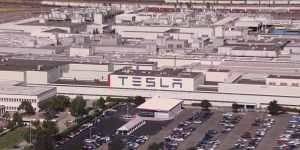 Tesla may make shiny, new, innovative, futuristic American automobiles, but the relentless pace at which it pushes its workers is producing the same old, tired, painful, debilitating and disabling injuries that we’ve always seen in the auto industry.
Tesla may make shiny, new, innovative, futuristic American automobiles, but the relentless pace at which it pushes its workers is producing the same old, tired, painful, debilitating and disabling injuries that we’ve always seen in the auto industry.
I take that back. Not the “same” injuries, but more of the same injuries.
Worksafe, a California-based organization that works to prevent injury, illness, and death by bringing justice to the workplace, issued a report earlier this week, finding that the rate of serious worker injuries at Tesla’s Fremont, California plant was approximately double the auto industry rate for 2015. And Tesla’s total recordable incidence rate (TRIR) in 2015 was 31 percent higher than the incident rate for the automobile industry, which is already double the injury rate for all workers. And looking at the rate for the most serious injuries, the DART rate (days away from work, restricted duty, or job transfer) for workers at the Fremont plant 7.9 per 100 workers, compared to the industry rate of 3.9, according to the Bureau of Labor Statistics.
Read the report. It also includes upsetting stories from two workers who suffered serious injuries at the plant. Charley Briese, a Tesla Production Associate, suffered three serious injuries — including a crushed thumb and severe tendinitis. Her job was to “pull down a hanging drill three times a minute for 12 to 16 hours a day. On a 12 hour shift, that means she made the same motion about 2,200 times a day, or 15,000 times a week, or 60,000 times a month.”
The relentless pace in the plant also caused Alan Ochoa to contract carpal tunnel syndrome in both wrists.
His job was to assemble door panels, a job that involved spot welding, operating a hand drill, and installing sound insulating materials. “I was the only one who was under 30 years old, one of the only ones able to keep up with the line,” he said. “But we started falling behind. The number one rule is that you can’t stop the line. They call it the Money Line — if you stop it for ten minutes they say it’s a million dollars out the door.”
Tesla is pushing back, claiming that in 2017, Tesla’s overall injury rate was dramatically better in the first quarter of the year:
“We may have had some challenges in the past as we were learning how to become a car company, but what matters is the future and with the changes we’ve made. We now have the lowest injury rate in the industry by far,” the Tesla statement said. “Our goal is to have as close to zero injuries as humanly possible and to become the safest factory in the auto industry.”
Worksafe counters that it’s still way to early to tell what the 2017 rate will be and that Tesla has a history of revising its injury numbers upward.
Zero injuries is a worthy goal, but it might be difficult considering the production pressures at Tesla. Even Forbes business magazine is skeptical:
“Currently, (Tesla CEO Elon] Musk is pushing the Tesla plant to boost vehicle output from fewer than 80,000 vehicles in 2016 to at least 100,000 this year, and a production rate reaching 500,000 units in 2018. By 2020, Musk wants to be able to build as many as 1 million vehicles annually, with the addition of the lower-priced Model 3 sedan and Model Y crossover.
Industry analysts are generally skeptical that the youngest U.S. automaker will be able to hit that target on Musk’s timetable.
When Tesla issued quarterly results this month, Musk said the company intends to reach a production rate for the new Model 3, priced from $35,000, of 5,000 units per week late this year “…and to 10,000 vehicles per week at some point in 2018.”
Although Musk has faced numerous hurdles at Tesla over the past decade, delivering the Model 3 on time and ramping up production as rapidly as hoped looks to be among his toughest. Doing so while ensuring maximum workplace safety makes that even more daunting.
And, of course, Tesla is blaming the report and worker complaints on a “‘concerted and professional’ media campaign on the part of United Automobile Workers,” which is trying to organize workers at the plant.
Let’s just take a moment to look at that statement which we often hear from companies during organizing campaigns, essentially alleging that the union is making up all of these safety and health problems in order to generate support for an organizing campaign. Actually, it’s just the opposite. It’s true that health and safety issues are often important parts of union organizing campaigns. And there’s a good reason for that which has nothing to do with making stuff up.
Workers often fear retaliation for speaking out about health and safety issues in their workplace, especially in unorganized workplaces. When an organizing campaign starts, workers feel empowered and protected, and the floodgates open. Where there have been suppressed health and safety problems, they naturally become organizing issues. Where there are no health and safety problems, those issues are not part of the organizing campaign.
Clearly, from workers’ testimony and the data, Tesla has problems. A relentless production pace is running up against the limits of the human body, an unfortunately common problem in the United States. We shall see if the workers at Tesla prevail in raising their voice in the workplace and increasing their control over their working conditions.
[…] you own a major car company, it can mean workers getting hurt or killed. Last May we wrote about a report chronicling Tesla’s poor safety record. And things apparently aren’t getting any […]